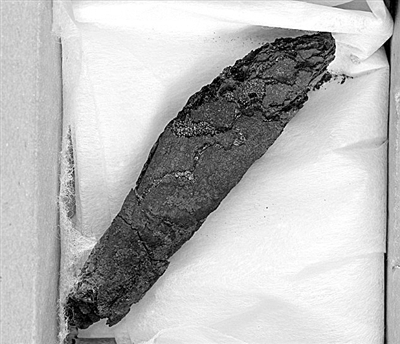(单词翻译:单击)
听力文本
This is Scientific American — 60-Second Science. I'm Cynthia Graber.
In the 1970s, researchers unearthing an ancient synagogue at Ein Gedi, near the Dead Sea, discovered the structure's Holy Ark—the container in which early Jews would have stored the Bible as they prayed. The site was home to a large Jewish community from about 800 BCE until a huge fire there in about 600 CE. That fire blackened and burned the scrolls in the ark. They crumbled if touched. So the Israeli scientists locked them away. Until now.
Penina Shor at the Israel Antiques Authority reached out to computer scientist Brent Seales at the University of Kentucky to see if he and his colleagues could use new technologies to peer inside a scroll without unrolling it. They call the technique virtual unwrapping.
Brent Seales explains: "First we have to find the layers within the scanned volume. Finding evidence of those layers is called segmentation. So there's a process for that. Once we find those layers we create a texture on those layers that comes from the scanned volume itself and that's where the ink evidence gets situated onto the layered surface. And then the final step is this unwrapping where we flatten out that surface, which is not actually flat, it's three dimensional. So that we can merge the pieces together and see the completely unwrapped scroll."

They applied this technique to the Ein Gedi scroll.
"So the first time we saw the text was in the lab and of course I don't speak or read Hebrew but we knew that it was writing because of the systematic way the markings were lined up, our early versions were not as clear as what we were able ultimately to produce. But of course we were elated because we knew that we had a scroll in which we would see the writing."
"But I think the real joy came when Penina sent me back the result of having read our first results because then I knew that not only were we seen writing but it was readable because she and her team were able to identify it as a known text and at that point were absolutely jubilant I have to say."
The Israeli scholars could clearly read the Hebrew. And they realized they were reading the book of Leviticus, one of the five books of Moses, the first five books of the Old Testament. It's the earliest Biblical book found inside an Ark, and the earliest surviving book outside of the Dead Sea Scrolls. The finding is in the journal Science Advances.
The researchers are thrilled not only with the discovery of the scroll's writing, but with the potential to use this application to peer inside other scrolled texts.
"I believe there are more discoveries to come. Damage and decay is the natural order of things. But you can see this sometimes, you can absolutely pull a text back from the brink of loss."
Thanks for listening for Scientific American — 60-Second Science Science. I'm Cynthia Graber.
参考译文
这里是科学美国人——60秒科学。我是辛西娅·格雷伯。
在20世纪70年代,研究人员在死海附近的恩戈地发掘出一个古老的犹太集会教堂,并因此发现了犹太教藏经柜的构造,这是早期犹太人用来存放祈祷用圣经的容器。这里在公元前800年到公元600年是一个大型犹太人聚集区,但公元600年发生的一场大火毁了这里。那场大火烧黑烧灼了藏经柜里的羊皮卷书。这些卷书一碰即毁。所以以色列科学家们只好把它们锁了起来,直道最近才重见天日。
以色列文物管理局的佩尼纳·肖尔和肯塔基大学的计算机科学家布伦特·希尔斯想知道,如果他们不将羊皮卷重新打开,是否可以利用现在新的技术来查看里面的内容。他们称这项技术为虚拟开封。
布伦特·希尔斯解释说:“首先,我们必须要找到扫描文卷中的层次。寻找这些层的证据被称为分割。有一个工序。一旦我们发现那些羊皮卷的层次,我们就会在扫描羊皮卷的那些层上弄出一些纹理,而墨渍位于羊皮卷的表层。最后一步就是打开我们平展过的表面,那里实际上已经不是平面,而是三维立体的。所以我们才能把这些羊皮卷拼在一起,从而看到完全展开的卷宗。”
他们把这项技术应用到在恩戈地发现的羊皮卷上。
“所以,我们第一次看到这些文本是在实验室里,虽然我不会说也不会读希伯来语,但是我们知道这上面写的是希伯来文字,因为这些符号排列的方式是有规则的,早期的版本不够清晰,不足以让我们解读出来。可是我们知道我们已经有了一个可以看到文字的羊皮卷,所以我们非常兴奋。”
“但是,当佩尼纳告诉我他们已经他们阅读了我们第一次拼出来的卷宗时,那是我真正高兴的时候,因为那时我知道不仅我们获得了上面的文字记录,而且她和她的团队能识别出这是一种可读的文本,所以那时,我们完全高兴到了极点。”
以色列的学者可以很清晰地阅读希伯来语。他们意识到自己正在阅读的是圣经旧约中的《利末记》, 这是摩西的5本著作之一,而这5本书是旧约的前五卷。这是最早的圣经著作,也是死海羊皮卷以外最早幸存下来的著作。该研究结果发表在《科学进展》杂志上。
令研究人员激动的是,他们不仅发现了羊皮卷上的文字,而且还可以利用这种技术来观察其它卷宗中的文本。
“我相信还将会有更多的发现。事物的耗损和衰败是自然规律。但是有时候,你完全可以将一个文本从消失的边缘挽救回来。”
谢谢大家收听科学美国人——60秒科学。我是辛西娅·格雷伯。
译文为可可英语翻译,未经授权请勿转载!
重点讲解
重点讲解:
1. lock away 把…锁起妥藏;
例句:The boy carefully locked away his toys.
那男孩把玩具小心地锁藏起来。
2. piece together 拼合;凑集;
例句:We managed to piece together the truth from several sketchy accounts.
我们从几方面粗略的说法中设法弄清了真相。
3. apply to 适用;适合;
例句:The results of this research can be applied to new developments in technology.
这项研究成果能应用于新的技术开发方面。
4. line up (使)(某一批人)排成行;(使)列队;
例句:The troops lined up in parade formation.
部队排成阅兵队形。


